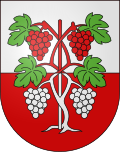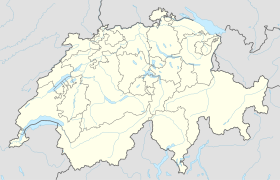Villette (Lavaux)
| Villette (Lavaux) | ||
|---|---|---|
| State : |
|
|
| Canton : |
|
|
| District : | Lavaux-Oron | |
| Municipality : | Bourg-en-Lavaux | |
| Postal code : | 1096 | |
| former BFS no. : | 5612 | |
| Coordinates : | 544 102 / 149 405 | |
| Height : | 397 m above sea level M. | |
| Area : | 1.36 km² | |
| Residents: | 581 (December 31, 2010) | |
| Population density : | 427 inhabitants per km² | |
| Website: | www.villette.ch | |
|
Villette (2005) |
||
| map | ||
|
|
||
Until July 1, 2011, Villette (Lavaux) was a municipality in the Lavaux-Oron district in the canton of Vaud in Switzerland . It merged with Cully , Epesses , Grandvaux and Riex to form the new political municipality of Bourg-en-Lavaux .
geography
Villette (Lavaux) is 397 m above sea level. M. , seven kilometers east-southeast of the canton capital of Lausanne (as the crow flies). The wine-growing village extends on the north bank of Lake Geneva , at the foot of the Lavaux vineyards .
The area of the 1.4 km² municipal area comprises a section of the Lavaux on the north bank of Lake Geneva (around 1100 m of the lakeshore line). The community soil extends from the lakeshore as a narrow strip northwards up the vineyards over the terrace of Jordillon to the adjacent high plateau southeast of the Jorat in the headwaters of the Bouteiller stream . Here, on the watershed between the catchment areas of the Rhone and Rhine , is 734 m above sea level. M. reached the highest point of Villette (Lavaux). In 1997, 26% of the municipal area was in settlements, 2% in forests and woodlands, 70% in agriculture and a little more than 2% was unproductive land.
Villette (Lavaux) includes the hamlets of Aran ( 467 m above sea level ), Châtagny ( 500 m above sea level ) and Montagny ( 470 m above sea level ), all on the slope of Lavaux in the middle of the vineyards, as well as some Individual courtyards on the plateaus. The neighboring municipalities of Villette (Lavaux) are Lutry , Savigny , Forel (Lavaux) and Grandvaux .
population
With 581 inhabitants (as of December 31, 2010), Villette (Lavaux) was one of the small communities in the canton of Vaud. 88.5% of the residents are French-speaking, 4.6% German-speaking and 2.0% English-speaking (as of 2000). The population of Villette (Lavaux) was 340 in 1900. After that, it remained fairly stable until 1960 (362 inhabitants). Since then there has been a significant increase in population, especially during the 1990s. Since the vineyard slope of Villette is protected, new buildings are mainly being built in the upper part of the municipality above the motorway.
economy
Until the second half of the 20th century, Villette (Lavaux) was predominantly an agricultural village. Even today, viticulture on the perfectly sunny slopes of Lavaux (around 45 hectares) plays an important role in the income structure of the population. In Villette (Lavaux) mainly quality wines from the Villette appellation are produced. Agriculture and animal husbandry predominate on the plateaus . Further jobs are available in local small businesses and especially in the service sector. In addition to everyday goods, the Villette (Lavaux) business is geared towards tourism. There are several wine shops. With the construction of numerous single-family houses in the last few decades, the village has developed into a residential community. Many employed people are therefore commuters who work mainly in Lausanne and the Vevey - Montreux region.
traffic
Villette (Lavaux) has good transport links. It is located on the main road 9 , which leads from Lausanne along the lakeshore via Vevey and Montreux into the Valais . The closest motorway connections to the A9 (Lausanne-Sion), which opened in 1974 and crosses the former municipality, are at Belmont (in the west, around 5 km away) and at Chexbres (in the east, around 8 km away). On April 2, 1861, the Lausanne-Villeneuve section of the Lausanne- Valais railway line went into operation with a station in Villette (Lavaux).
history
Since the 11th century, Villette (Lavaux) was under the Bishop of Lausanne. His church, already mentioned around 1134, was the parish church of the whole of today's Cercle de Cully . With the conquest of Vaud by Bern in 1536, Villette (Lavaux) came under the administration of the Bailiwick of Lausanne . After the collapse of the Ancien Régime , the village belonged to the canton of Léman from 1798 to 1803 during the Helvetic Republic , which then became part of the canton of Vaud when the mediation constitution came into force . In 1798 it was assigned to the Lavaux district.
Villette (Lavaux) formed a large municipality until 1824. Thereafter, Grandvaux, Cully, Riex, Epesses and Forel (Lavaux) became independent, and Villette (Lavaux) received the borders that were in force until the merger to form the municipality of Bourg-en-Lavaux on July 1, 2011. Since 1864, the municipal administration of Villette was in the hamlet of Aran. A project to merge the five municipalities of Cully, Epesses, Riex, Grandvaux and Villette (Lavaux) initially failed in a vote on February 27, 2005 due to resistance from the people of Grandvaux.
Attractions
The reformed parish church of Saint-Saturnin in Villette dates from the 13th and 14th centuries in its current form. Wall paintings from the 14th and 15th centuries have been preserved in the choir. At the entrance to the village is the so-called Landvogthaus, a late Gothic building with a half-hip roof that was built in the 16th century. Aran has also retained the appearance of a typical wine-growing village.





